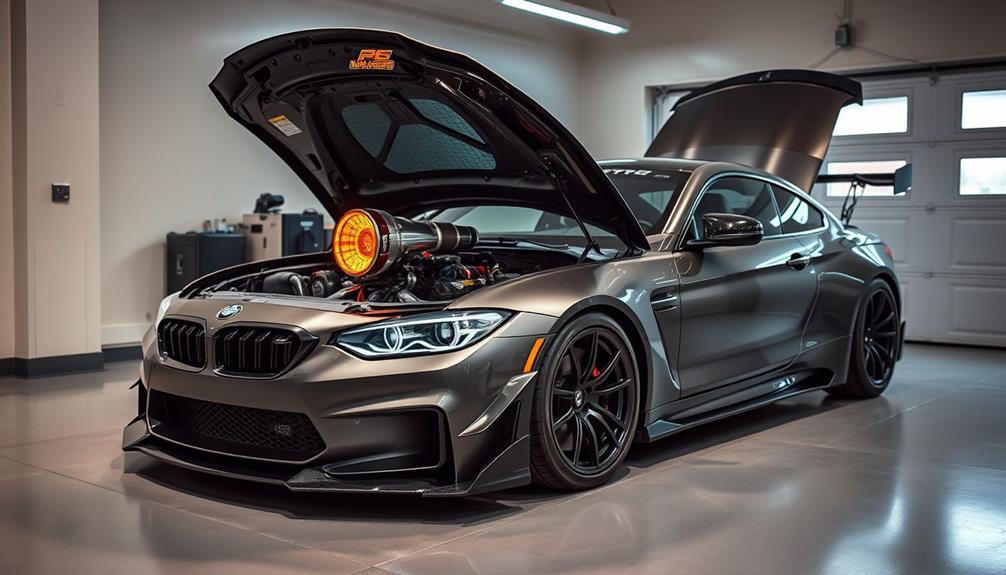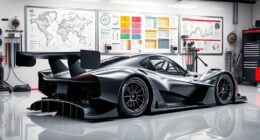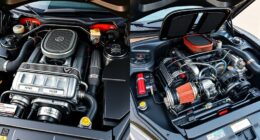Car tuning progresses through four stages, each transforming your ride from mild to wild. Stage 1 involves basic modifications like performance chips that enhance your car's ECU for better output. In Stage 2, you optimize airflow with upgrades like cold air intakes and performance exhaust systems. Stage 3 introduces advanced modifications, such as turbochargers and custom tuning for peak performance. Finally, Stage 4 is all about extreme enhancements—engine swaps and nitrous systems designed for serious power. Choosing the right stage is essential, and there's so much more to explore to fully understand what fits your goals.
Key Takeaways
- Stage 1: Basic Modifications enhance performance through ECU reprogramming, requiring minimal installation skills and providing modest horsepower gains.
- Stage 2: Airflow Optimization involves upgrading intake and exhaust systems for improved airflow and requires ECU remapping for optimal efficiency.
- Stage 3: Advanced Modifications focus on significant upgrades like turbochargers and custom tuning, ensuring adequate fuel and air management for enhanced performance.
- Stage 4: Extreme Performance includes extensive modifications such as engine swaps, necessitating substantial investment and rigorous maintenance to handle increased stress.
- Selecting the Right Stage depends on vehicle use; stages 1 and 2 suit daily drivers, while stages 3 and 4 cater to track-ready enthusiasts.
Overview of Tuning Stages
When it comes to car tuning, understanding the different stages is crucial for any enthusiast. Tuning stages categorize your vehicle modifications, starting from basic enhancements to extreme upgrades.
You'll find that Stage 1 tuning typically involves ECU remapping and minor adjustments that yield performance gains in horsepower and torque without requiring considerable hardware changes. It's an ideal entry point for those looking to boost their vehicle's performance while keeping costs manageable.
As you progress to Stage 2, you'll focus on optimizing airflow. This stage often includes installing a cold air intake and a performance exhaust system, which can greatly enhance engine efficiency.
However, these modifications usually require further ECU adjustments to guarantee you're getting the best performance gains.
Stages 3 and 4 delve into more extensive modifications, such as replacing internal engine components and adding forced induction systems. These stages involve expert knowledge and a larger investment, suitable for those aiming for track-ready capabilities.
Each tuning stage demands careful planning and consideration of your vehicle's compatibility, along with adherence to local laws regarding emissions and modifications.
Stage 1: Performance Chips

Stage 1 tuning is your gateway to enhancing your vehicle's performance with minimal complexity. By installing performance chips or plug-and-play tuners, you can easily reprogram your ECU to optimize fuel delivery and ignition timing. This entry-level tuning option provides modest gains in horsepower and torque, making it ideal for daily drivers looking for slight improvements without heavy modifications.
Here's a quick overview of what you can expect from Stage 1 tuning:
| Feature | Benefits |
|---|---|
| Performance Chips | Reprograms ECU for better output |
| Fuel Delivery | More efficient fuel usage |
| Ignition Timing | Enhanced engine response |
| Horsepower Increase | Modest but noticeable gains |
Compatibility with your specific vehicle is essential, as not all performance chips are suitable for every make and model. The installation process is generally straightforward and doesn't require advanced technical skills. Popular options, like the Pedal Commander, offer instant performance boosts without the need for complex modifications. With Stage 1 tuning, you're set to enjoy a more spirited driving experience while maintaining reliability.
Stage 2: Intake and Exhaust

In Stage 2 tuning, you'll focus on optimizing airflow with upgrades like cold air intakes and performance exhaust systems.
These modifications not only enhance combustion efficiency but also give your vehicle a sportier sound.
To fully benefit from these changes, you'll need to make ECU mapping adjustments to accommodate the new hardware.
Airflow Optimization Techniques
Optimizing airflow is fundamental for enhancing your vehicle's performance, and Stage 2 tuning focuses on considerable upgrades to both the intake and exhaust systems.
One of the most effective methods for airflow optimization is installing cold air intakes. These systems deliver cooler air to your engine, improving combustion efficiency and ultimately boosting horsepower and torque.
In conjunction with cold air intakes, upgrading to a performance air filter can also enhance airflow, allowing your engine to breathe easier.
Additionally, performance exhaust systems are essential as they reduce backpressure and improve exhaust flow, leading to better engine sound and increased power output.
You might find that combining these intake and exhaust upgrades with your Stage 1 tuning can lead to considerable performance improvements.
However, it's critical to evaluate ECU remapping after these modifications to guarantee your engine runs efficiently with the increased airflow.
Implementing these airflow optimization techniques will yield modest gains in horsepower and torque, greatly contributing to your vehicle's overall performance.
With the right upgrades, you'll notice a more responsive engine and a thrilling driving experience.
Performance Exhaust Benefits
Upgrading to a performance exhaust system is one of the most impactful modifications you can make for your vehicle. A performance exhaust greatly improves exhaust flow, which enhances engine efficiency and leads to noticeable increases in horsepower and torque.
You'll enjoy a more aggressive sound that many enthusiasts crave, making your driving experience even more thrilling.
When paired with a cold air intake, a performance exhaust further optimizes airflow, resulting in even greater performance gains. This combination allows your engine to breathe better, which translates to more power on demand.
Additionally, performance exhaust systems often utilize lighter materials like stainless steel or titanium, reducing overall vehicle weight and improving handling dynamics.
While you'll gain impressive benefits from your new exhaust, it's crucial to take into account ECU remapping. This adjustment guarantees that your vehicle's engine management system fully capitalizes on the improved airflow characteristics provided by the performance exhaust.
By making this change, you maximize the potential of your engine, allowing you to experience the true power of your tuning upgrades.
ECU Mapping Adjustments
Fine-tuning your vehicle's ECU after installing intake and exhaust upgrades is essential for releasing the full potential of your modifications.
ECU mapping adjustments are important to optimizing engine performance, recalibrating fuel delivery and ignition timing to match the increased airflow from your upgrades. By doing this, you can achieve power gains of 10-30%, greatly enhancing your vehicle's horsepower and torque.
To make sure that your engine runs smoothly, it's essential to reprogram the ECU. This step prevents issues like engine knock or running too lean, which could lead to long-term damage to engine components.
Many tuners rely on dyno testing during the ECU mapping process to fine-tune the settings, guaranteeing the best performance results while maintaining reliability.
Additionally, proper ECU mapping can improve fuel efficiency, allowing your engine to operate more effectively with the upgraded intake and exhaust systems.
By taking the time to adjust your ECU after Stage 2 modifications, you're not just revealing potential power; you're also investing in the longevity and health of your engine.
Don't overlook this key step in your tuning journey!
Stage 3: Advanced Modifications

In Stage 3 tuning, you're stepping up to major engine upgrades that boost your car's power considerably.
You'll need custom tuning to optimize these modifications, ensuring everything runs smoothly and efficiently.
This stage demands careful attention and expertise, so working with qualified mechanics is essential to avoid any mishaps.
Major Engine Upgrades
Stage 3 tuning represents a significant leap in performance, bringing your vehicle to its peak potential. At this stage, you'll be making major engine upgrades that meet your performance needs.
One of the most impactful changes is the installation of a turbocharger or supercharger. These additions enhance your air intake system, allowing for more air to enter the engine, which is essential for improving power output.
Upgrading components like forged pistons and stronger clutches is important to handle the increased power levels effectively. You'll also need to install upgraded fuel injectors and pumps, guaranteeing your engine gets enough fuel to match the enhanced air supply.
Don't forget about cooling the air, as heat can lead to engine failure; intercoolers are a must-have for maintaining prime temperatures.
Additionally, professional installation and custom tuning are critical to fine-tune fuel delivery and ignition timing. This guarantees that all your modified components work harmoniously, maximizing efficiency and longevity.
Custom Tuning Requirements
Achieving peak performance in your vehicle demands a thoughtful approach to custom tuning after implementing notable upgrades. At Stage 3, you're dealing with advanced modifications like camshaft and piston upgrades, along with the installation of turbochargers or superchargers.
These enhancements greatly boost engine performance, but without proper custom tuning, you won't maximize their potential.
Custom tuning is vital at this stage to optimize fuel delivery, ignition timing, and boost levels. It guarantees that your new hardware works harmoniously, delivering maximum power output and reliability.
Expect to use specialized tools and expertise to manage the complex installations and adjustments required. This is where serious automotive enthusiasts truly shine.
Here are some key elements to keep in mind during your custom tuning process:
- Upgraded fuel injectors for improved fuel delivery
- Stronger clutches to handle increased torque
- Bespoke drivetrain components to optimize performance
- Rolling road testing to fine-tune performance parameters
- Professional assistance to facilitate effective modifications
Stage 4: Extreme Performance

While many tuning enthusiasts stop at earlier stages, those who venture into Stage 4 tuning embrace the pinnacle of automotive performance. This stage involves extreme modifications like engine swaps, bore-and-stroke kits, and highly complex turbocharger or supercharger setups. Achieving this level of performance often requires a significant financial investment, with costs exceeding $10,000.
Understanding your investment goals is essential as you allocate funds towards these modifications.
At this stage, tuning companies focus on optimizing every aspect of your vehicle. Custom ECU tuning is essential; it guarantees that the extensive modifications work in harmony, maximizing power output while maintaining engine longevity. You may also incorporate high-performance parts like nitrous injection systems and bespoke drivetrain components, elevating your car's capabilities to compete on the track.
However, don't underestimate the commitment Stage 4 demands. Vehicles modified at this level require rigorous maintenance and monitoring due to the extra stress on engine components.
You'll need to be prepared for a hands-on approach, keeping a close eye on your cylinder head and other crucial systems. If you're an experienced enthusiast seeking unparalleled racing capabilities, Stage 4 tuning is your gateway to extreme performance.
Selecting Your Tuning Stage

Choosing the right tuning stage can greatly impact your vehicle's performance and your driving experience. Start by identifying your performance goals and budget.
If you're a daily driver looking for modest enhancements, stages 1 and 2 might be the way to go. Stage 1 usually involves ECU reprogramming for slight power gains, while Stage 2 focuses on hardware upgrades like intake and exhaust systems, often requiring additional ECU mapping.
For those aiming for track-ready capabilities, stages 3 and 4 offer extensive modifications, including internal engine components and forced induction systems. Consulting with an expert is vital here to guarantee successful upgrades and compatibility with your specific vehicle make and model.
Before diving into modifications, keep the following in mind:
- Assess your performance goals and budget.
- Understand the implications of ECU reprogramming.
- Research necessary hardware upgrades.
- Confirm compatibility with your vehicle.
- Check local laws for compliance to avoid legal issues.
Frequently Asked Questions
What Are the Different Stages of Car Tuning?
When considering car tuning, you'll encounter various stages. Each one builds on the last, starting with simple adjustments for efficiency, then adding more complex modifications, ultimately leading to high-performance upgrades that demand significant investment and expertise. At the first stage of car tuning, many owners focus on small changes such as tire pressure, air filter upgrades, and basic engine tuning. As they progress through the car tuning stages, they may move on to more advanced modifications like exhaust system upgrades, turbochargers, and advanced engine management systems. The final stage of car tuning involves major upgrades like engine swaps, suspension overhauls, and custom fabricated components. These high-performance upgrades often require the expertise of skilled mechanics and substantial financial investment.
What Is Stage 4 Car Tuning?
Stage 4 car tuning's all about extreme performance upgrades. You'll swap engines, add turbochargers, and invest heavily. Custom ECU tuning's essential for reliability, and ongoing maintenance is key to handling the increased power demands.
What Are the Different Types of Vehicle Tuning?
When exploring vehicle tuning, you'll encounter various types, such as ECU remapping for minor boosts, hardware upgrades for better performance, and extensive modifications for serious power. Each type aligns with your specific goals and budget.
What Is Stage 5 Tuning?
Stage 5 tuning's like launching a rocket; you're swapping engines, adding powerful boost systems, and fine-tuning your ECU. It demands a hefty investment and specialized skills to handle the extreme performance and maintenance required.
Conclusion
To sum up, choosing the right tuning stage can transform your car from a humble sedan into an absolute beast on the road. Whether you start with performance chips or immerse yourself in extreme modifications, each stage offers exciting possibilities that'll make you feel like you're driving a rocket. So, pick your path wisely, and get ready to release the full potential of your ride. The thrill of the journey is just as thrilling as the destination!










